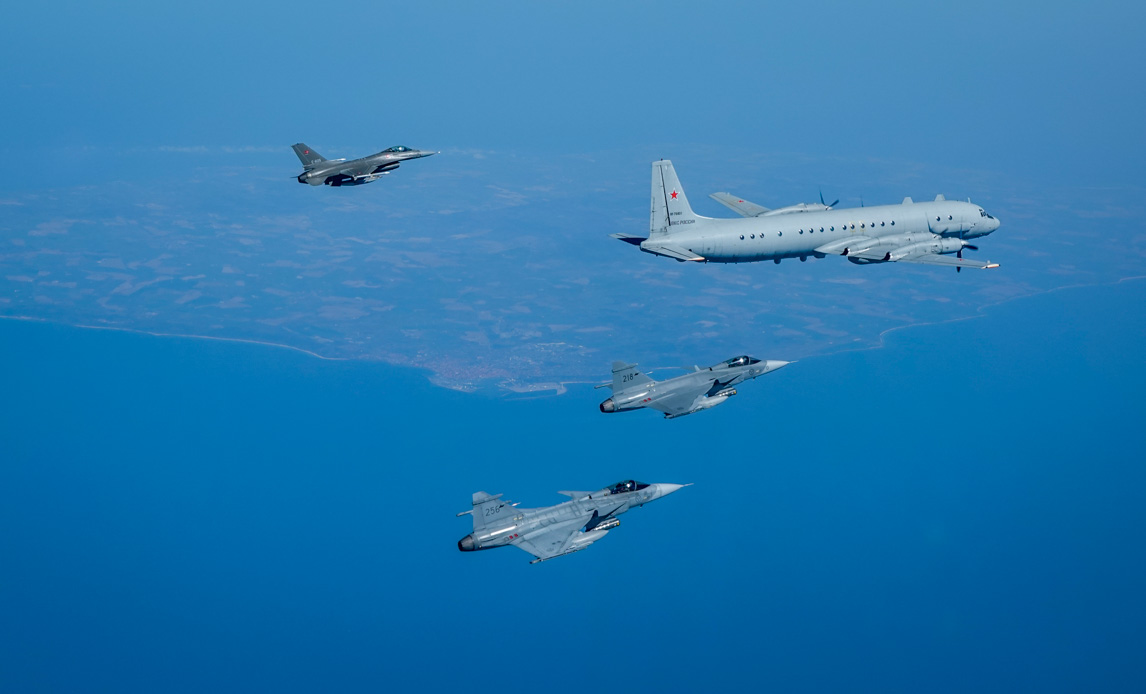Denmark and Sweden meet Russian aircraft together
Thursday afternoon the Danish and Swedish Quick Reaction Alert jets a Russian military aircraft in the airspace over the Baltic Sea. This is the first time that Denmark and Sweden have worked together in this way.

Danish and Swedish fighters meets Russian military aircraft. Photo: The Danish Armed Forces
By the Defence Command Denmark
"Today's operation shows how far we have come in our cooperation with Sweden. It is the fruit of several years of hard work tying the Nordic countries closer together. It is very satisfying to see the collaboration run so smoothly", says Lieutenant Colonel Hans Skovmose, who is head of the Operations Department in Danish Air Command.
The four fighter jets met on Thursday 20 April just after one o’clock over the Baltic Sea between Sweden, Zealand and Bornholm. There they met a Russian COOT-A military aircraft which was heading west from Kaliningrad. After finding the plane and following it on its route, the three nations' planes separated and returned to their respective home bases.
"We live in an uncertain time, which is fundamentally affected by Russia's aggressive behaviour. We must expect that the Baltic Sea area will be characterized by a higher level of tension than we have been used to. We have close and solid cooperation with Sweden, which is why we also look very positively on Swedish NATO membership, which will strengthen security in the Nordic region, in Europe and the entire transatlantic area”, says acting Defense Minister Troels Lund Poulsen.
The Danish and Swedish aircraft were under their own national command during the entire process and the Russian plane was in international airspace during the entire mission.
Although it is a breakthrough, the mission itself was in reality a routine task. Russian planes patrol the Baltic Sea at regular intervals, and their flight patterns often prompt Denmark or one or more of our neighbouring countries sending up fighter planes. What made the mission special was that the collaboration was planned in advance.
"Our air forces regularly train together, so it is not new for us to cooperate both in the air and on the ground, but it is new that we show a common front in this way regarding the enforcement of sovereignty in the airspace. It shows strong unity", says Hans Skovmose.
Undecided
Whether Denmark and Sweden will do more tasks of this type together in the future has not been decided, but the collaboration is expected to be here to stay.
"A decision has not been made as to whether joint scrambling of combat aircraft is something that should happen more often, but now we know that we can coordinate this type of mission on short notice, and that in itself shows that the cooperation is strong, ” says Hans Skovmose.
On alert
The Danish Air Force's Quick Reaction Force consists of two aircraft that are on standby 24 hours a day at Skrydstrup Air Force Base in the south of Jutland. From here, the National Air Operations Center sends the planes up when Air Control Wing's radar operators receive information that there is unidentified traffic in the immediate area. Read more about the Danish QRA here (link).